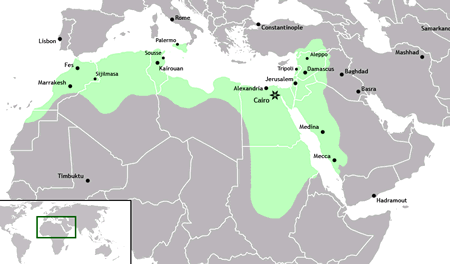 |
| Fatimid dynasty map |
The Fatimid dynasty (named after the prophet Muhammad’s daughter Fatima, from whom the Fatimids claimed descent) was a Shi’i dynasty founded by Abd Allah. Although he was an Isma’ili, Abd Tuhan did not claim descent from the Imam Isma’il but from the Prophet’s family. When his beliefs led to his persecution in Syria, where most were Sunni Muslims, Abd Tuhan fled to North Africa, where he established a stronghold in Tunisia.
He declared himself the Mahdi and was known as Abd Tuhan al-Mahdi; he established his capital in the city of Mahidiya along the Tunisian coast. His followers crushed local rulers and branches of Shi’ism that had gained support among the Berbers. The Fatimids were especially opposed to the Kharijites, whose egalitarian principles were the opposite of their rigid religious hierarchy.
After three failed attempts to take Egypt with its rich Nile Valley, the renowned Fatimid general Jawhar al-Rumi, a former Greek slave, conquered Egypt in 969. Under Abd Allah’s great grandson al-Mu’izz (r. 953–976), the Fatimids built Cairo on the outskirts of the old Arab capital of Fustat as their new religious and administrative city. Fatimid Cairo was a walled city of palaces, mosques, and army barracks.
The Fatimids extended their rule over Palestine and Syria but were unable to overthrow the caliphate in Baghdad. At the zenith of their power, the Fatimids controlled the territory from the Orontes in Syria across North Africa. The Assassins, an offshoot of Isma’ili Fatimids, established strongholds in Syria and Persia seeking to undermine and, if possible, destroy Sunni belief and rulers.
Although they were zealous missionaries for their particular brand of Islam elsewhere, in Egypt the Fatimids were relatively benign and most of the population remained committed to orthodox Sunni practices. The Copts were retained as administrators over most of the financial affairs of state, as they had been since the Umayyad dynasty. Caliph al-Hakim (r. 996–1021) was a notable exception to Fatimid tolerance in Egypt.
Under his rule, Christians and Jews were persecuted and many churches and synagogues destroyed. His followers became known as the Druze. After al-Hakim was assassinated in 1021 his followers alleged that he had been hidden by God, not killed, much like the 12th imam, and fled Egypt for the relative security of remote mountain areas in Lebanon.
 |
| Dinar Cairo Egypt Fatimid Gold Coin Misr 364 AH 975 AD |
The Fatimid navy played a key role in the dynasty’s power and wealth as it controlled the central Mediterranean and the Red Sea routes. The Fatimids also increased trans-Saharan trade. The Fatimids traded luxury goods and agricultural products with the west and east as far as India. Fatimid rulers established al-Azhar University, which became famous throughout the Muslim world, as well as numerous public buildings and commercial centers.
Two branches of the Fatimids, the Almoravids and Almohads (Unitiarians) led by Ibn Tumert, established separate dynasties in Morocco. To strengthen their armed forces the Fatimids imported slave and free Turkish soldiers but the growing dependency on outside forces gradually weakened dynasty. Thus Saladin (Salah ad din, Yusuf) had little difficulty in overthrowing the Fatimids and returning the territories to Sunni Muslim rule in 1171.
 |
| inside al-Azhar mosque |
EmoticonEmoticon